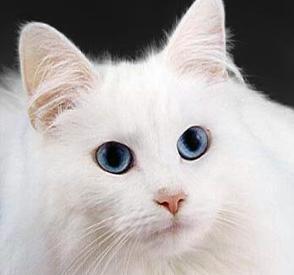
All three colour variations developed from the original Russian Blue – a cat that was first seen in the 1860s. Because of the Russian Blue’s unique appearance and temperament, many cat enthusiasts wanted to experiment with coat colour and patterning, whilst retaining the desirable traits of the Blue. In 1971, a program to develop a Russian White began in Australia at the Myemgay Cattery. A beautiful white Siberian was acquired in an exchange, and Dick and Mavis Jones decided to breed it to their Russian Blue stud, Myemgay Yuri. This resulted in two white kittens, one of which, named ‘White Rose,’ was bred back to Myemgay Yuri. When four generations had been bred, the Jones’ applied for full registration status. This was granted by the Royal Agricultural Society in November, 1975. Both the Russian White and the Russian Black achieved championship status from the American Cat Fanciers Association in 2010.
Many worldwide cat registries, especially in the United States, do not recognise the Russian in any other colour than blue. Like the Russian Blue, these three varieties boast a double coat that is dense, plush and soft to the touch, and will have aided the cat in the cold climes where it came from. Further traits include a long body, slender legs, wide-spaced ears that are round-tipped, slightly oblique eyes and a tapering nose. The only true difference between the three Russian variations is coat colouring; the Russian White possesses a svelte white coat, whilst the Russian Black is pure ebony and the Russian Tabby can be easily identifiable by its striped tabby markings.
Owners, breeders and enthusiasts have described the Russian (of any deviation) as a lively and funny cat that is full of life and character. Although the Russian is highly active, it can adapt well to being housed exclusively indoors which is something most owners will favour because of the breed’s rarity. Sometimes described as possessing more canine than feline traits, the Russian is an affectionate and gentle cat with a huge capacity for love and loyalty. It is often the case that a Russian will bond well with its immediate family, whilst remaining indifferent towards strangers. In order to keep your Russian cat stimulated throughout the day, it is important to provide a variety of interactive toys and playthings. Generally speaking, a healthy Russian will weigh 12 pounds, with a typical life expectancy of 12-15 years.
The Russian is a very healthy and resilient breed with a long life expectancy. No genetic or breed-specific health conditions are documented in the breed, although cases of bladder stones are seen.








Big cat. big boned, short legs and tail, not much of a jumper (can't reach the kitchen counter), Dark brown and black tabby with white under her nose and chin. shorter tail than most cats.